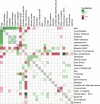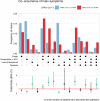Symptom-based early-stage differentiation between SARS-CoV-2 versus other respiratory tract infections-Upper Silesia pilot study
- PMID: 34193945
- PMCID: PMC8245528
- DOI: 10.1038/s41598-021-93046-6
Symptom-based early-stage differentiation between SARS-CoV-2 versus other respiratory tract infections-Upper Silesia pilot study
Abstract
In the DECODE project, data were collected from 3,114 surveys filled by symptomatic patients RT-qPCR tested for SARS-CoV-2 in a single university centre in March-September 2020. The population demonstrated balanced sex and age with 759 SARS-CoV-2( +) patients. The most discriminative symptoms in SARS-CoV-2( +) patients at early infection stage were loss of taste/smell (OR = 3.33, p < 0.0001), body temperature above 38℃ (OR = 1.67, p < 0.0001), muscle aches (OR = 1.30, p = 0.0242), headache (OR = 1.27, p = 0.0405), cough (OR = 1.26, p = 0.0477). Dyspnea was more often reported among SARS-CoV-2(-) (OR = 0.55, p < 0.0001). Cough and dyspnea were 3.5 times more frequent among SARS-CoV-2(-) (OR = 0.28, p < 0.0001). Co-occurrence of cough, muscle aches, headache, loss of taste/smell (OR = 4.72, p = 0.0015) appeared significant, although co-occurrence of two symptoms only, cough and loss of smell or taste, means OR = 2.49 (p < 0.0001). Temperature > 38℃ with cough was most frequent in men (20%), while loss of taste/smell with cough in women (17%). For younger people, taste/smell impairment is sufficient to characterise infection, whereas in older patients co-occurrence of fever and cough is necessary. The presented study objectifies the single symptoms and interactions significance in COVID-19 diagnoses and demonstrates diverse symptomatology in patient groups.
Conflict of interest statement
The authors declare no competing interests.
Figures




Similar articles
-
Signs and symptoms to determine if a patient presenting in primary care or hospital outpatient settings has COVID-19.Cochrane Database Syst Rev. 2021 Feb 23;2(2):CD013665. doi: 10.1002/14651858.CD013665.pub2. Cochrane Database Syst Rev. 2021. Update in: Cochrane Database Syst Rev. 2022 May 20;5:CD013665. doi: 10.1002/14651858.CD013665.pub3. PMID: 33620086 Free PMC article. Updated.
-
Distorted chemosensory perception and female sex associate with persistent smell and/or taste loss in people with SARS-CoV-2 antibodies: a community based cohort study investigating clinical course and resolution of acute smell and/or taste loss in people with and without SARS-CoV-2 antibodies in London, UK.BMC Infect Dis. 2021 Feb 25;21(1):221. doi: 10.1186/s12879-021-05927-w. BMC Infect Dis. 2021. PMID: 33632171 Free PMC article.
-
Olfactory and gustatory dysfunctions as a clinical presentation of mild-to-moderate forms of the coronavirus disease (COVID-19): a multicenter European study.Eur Arch Otorhinolaryngol. 2020 Aug;277(8):2251-2261. doi: 10.1007/s00405-020-05965-1. Epub 2020 Apr 6. Eur Arch Otorhinolaryngol. 2020. PMID: 32253535 Free PMC article.
-
Alteration of Smell and Taste in Asymptomatic and Symptomatic COVID-19 Patients in Sicily, Italy.Ear Nose Throat J. 2021 Apr;100(2_suppl):182S-185S. doi: 10.1177/0145561320981447. Epub 2020 Dec 22. Ear Nose Throat J. 2021. PMID: 33350319
-
Symptom Profiles and Progression in Hospitalized and Nonhospitalized Patients with Coronavirus Disease, Colorado, USA, 2020.Emerg Infect Dis. 2021 Feb;27(2):385-395. doi: 10.3201/eid2702.203729. Emerg Infect Dis. 2021. PMID: 33496225 Free PMC article. Review.
Cited by
-
Prospective Assessment of Symptoms to Evaluate Asymptomatic SARS-CoV-2 Infections in a Cohort of Health Care Workers.Open Forum Infect Dis. 2022 Feb 14;9(3):ofac030. doi: 10.1093/ofid/ofac030. eCollection 2022 Mar. Open Forum Infect Dis. 2022. PMID: 35198647 Free PMC article.
-
Performance and explainability of feature selection-boosted tree-based classifiers for COVID-19 detection.Heliyon. 2023 Dec 7;10(1):e23219. doi: 10.1016/j.heliyon.2023.e23219. eCollection 2024 Jan 15. Heliyon. 2023. PMID: 38170121 Free PMC article.
-
Virus and viral components transmitted through surgical smoke; a silent danger in operating room: a systematic review.BMC Surg. 2024 Aug 9;24(1):227. doi: 10.1186/s12893-024-02514-z. BMC Surg. 2024. PMID: 39123160 Free PMC article.
-
Epidemiological, clinical and laboratory profile of patients presenting with severe acute respiratory syndrome (SARS-CoV-2) in Ethiopia.PLoS One. 2023 Dec 1;18(12):e0295177. doi: 10.1371/journal.pone.0295177. eCollection 2023. PLoS One. 2023. PMID: 38039278 Free PMC article.
References
-
- Novel Coronavirus Pneumonia Emergency Response Epidemiology Team The epidemiological characteristics of an outbreak of 2019 novel coronavirus diseases (COVID-19) in China. Zhonghua Liu Xing Bing Xue Za Zhi. 2020;41:145–151. - PubMed
Publication types
MeSH terms
LinkOut - more resources
Full Text Sources
Medical
Miscellaneous

